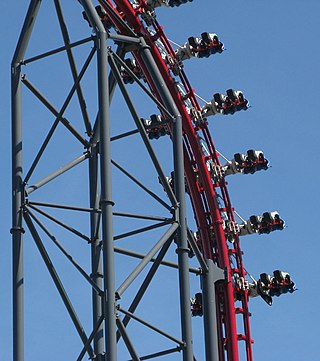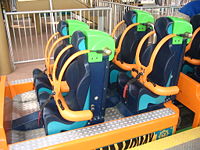
A movie theater, cinema, or cinema hall, also known as a movie house, picture house, the movies, the pictures, picture theater, the silver screen, the big screen, or simply theater is a building that contains auditoria for viewing films for public entertainment. Most, but not all, movie theaters are commercial operations catering to the general public, who attend by purchasing tickets.

A roller coaster, or rollercoaster, is a type of amusement ride that employs a form of elevated railroad track designed with tight turns, steep slopes, and sometimes inversions. Passengers ride along the track in open cars, and the rides are often found in amusement parks and theme parks around the world. LaMarcus Adna Thompson obtained one of the first known patents for a roller coaster design in 1885, related to the Switchback Railway that opened a year earlier at Coney Island. The track in a coaster design does not necessarily have to be a complete circuit, as shuttle roller coasters demonstrate. Most roller coasters have multiple cars in which passengers sit and are restrained. Two or more cars hooked together are called a train. Some roller coasters, notably Wild Mouse roller coasters, run with single cars.

An arena is a large enclosed platform, often circular or oval-shaped, designed to showcase theatre, musical performances, or sporting events. It is composed of a large open space surrounded on most or all sides by tiered seating for spectators, and may be covered by a roof. The key feature of an arena is that the event space is the lowest point, allowing maximum visibility. Arenas are usually designed to accommodate a multitude of spectators.

An aisle is, in general, a space for walking with rows of non-walking spaces on both sides. Aisles with seating on both sides can be seen in airplanes, certain types of buildings, such as churches, cathedrals, synagogues, meeting halls, parliaments and legislatures, courtrooms, theatres, and in certain types of passenger vehicles. Their floors may be flat or, as in theatres, stepped upwards from a stage.

An auditorium is a room built to enable an audience to hear and watch performances. For movie theatres, the number of auditoria is expressed as the number of screens. Auditoria can be found in entertainment venues, community halls, and theaters, and may be used for rehearsal, presentation, performing arts productions, or as a learning space.

In theatre and performing arts, the stage is a designated space for the performance of productions. The stage serves as a space for actors or performers and a focal point for the audience. As an architectural feature, the stage may consist of a platform or series of platforms. In some cases, these may be temporary or adjustable but in theaters and other buildings devoted to such productions, the stage is often a permanent feature.

A theater, theatre or playhouse, is a structure where theatrical works, performing arts and musical concerts are presented. The theater building serves to define the performance and audience spaces. The facility usually is organized to provide support areas for performers, the technical crew and the audience members, as well as the stage where the performance takes place.

The luxury box and club seating constitute the most exclusive class of seating in arenas and stadiums, and generate much higher revenues than regular seating. Club ticketholders often receive exclusive access to an indoor part of the venue through private club entrances, to areas containing special restaurants, bars, merchandise stands, and lounge areas of the venue that are not otherwise available to regular ticketholders.

Seating capacity is the number of people who can be seated in a specific space, in terms of both the physical space available, and limitations set by law. Seating capacity can be used in the description of anything ranging from an automobile that seats two to a stadium that seats hundreds of thousands of people. The largest sporting venue in the world, the Indianapolis Motor Speedway, has a permanent seating capacity for more than 235,000 people and infield seating that raises capacity to an approximate 400,000.

A hypercoaster can mean one of two things:

A music venue is any location used for a concert or musical performance. Music venues range in size and location, from a small coffeehouse for folk music shows, an outdoor bandshell or bandstand or a concert hall to an indoor sports stadium. Typically, different types of venues host different genres of music. Opera houses, bandshells, and concert halls host classical music performances, whereas public houses ("pubs"), nightclubs, and discothèques offer music in contemporary genres, such as rock, dance, country, and pop.

In live entertainment, there are several possible schemes for the seating assignment of spectators—including completely unassigned seating. There are several schemes which are most commonly used, though there are no hard and fast rules and alternate or modified schemes are sometimes used as is suitable to the event.

A wheelchair-accessible van is a vehicle that has been modified by increasing the interior size of the vehicle and equipping it with a means of wheelchair entry, such as a wheelchair ramp or powered lift.

A fourth-dimension roller coaster is a type of steel roller coaster whereby riders are rotated independently of the orientation of the track, generally about a horizontal axis that is perpendicular to the track. The cars do not necessarily need to be fixed to an angle.

The Dive Coaster is a steel roller coaster model developed and engineered by Bolliger & Mabillard. The design features one or more near-vertical drops that are approximately 90 degrees, which provide a moment of free-falling for passengers. The experience is enhanced by unique trains that seat up to ten riders per row, spanning only two or three rows total. Unlike traditional train design, this distinguishing aspect gives all passengers virtually the same experience throughout the course of the ride. Another defining characteristic of Dive Coasters is the holding brake at the top of the lift hill that holds the train momentarily right as it enters the first drop, suspending some passengers with a view looking straight down and releasing suddenly moments later.

Furius Baco is a hydraulically launched steel roller coaster located at PortAventura Park in the resort PortAventura World, Salou, Catalonia, Spain. Manufactured by Intamin, the ride opened on June 5, 2007 as the fastest roller coaster in Europe at 83.9 mph, which the ride reaches in 3 seconds, although this record has since been surpassed by Red Force at neighboring Ferrari Land. Since opening, the ride has experienced some technical problems, and as a result has had to shut down for varying periods of time during opening hours.
There are different types of theatres, but they all have three major parts in common. Theatres are divided into two main sections, the house and the stage; there is also a backstage area in many theatres. The house is the seating area for guests watching a performance and the stage is where the actual performance is given. The backstage area is usually restricted to people who are producing or in the performance.

A wheelchair is a chair with wheels, used when walking is difficult or impossible due to illness, injury, problems related to old age, or disability.
In architecture, sightlines are a particularly important consideration in the design of civic structures, such as a stage, arena, or monument. They determine the configuration of such items as theater and stadium design, road junction layout and urban planning. In cities such as London, construction within sightlines is restricted to protect the key views of famous landmarks




















